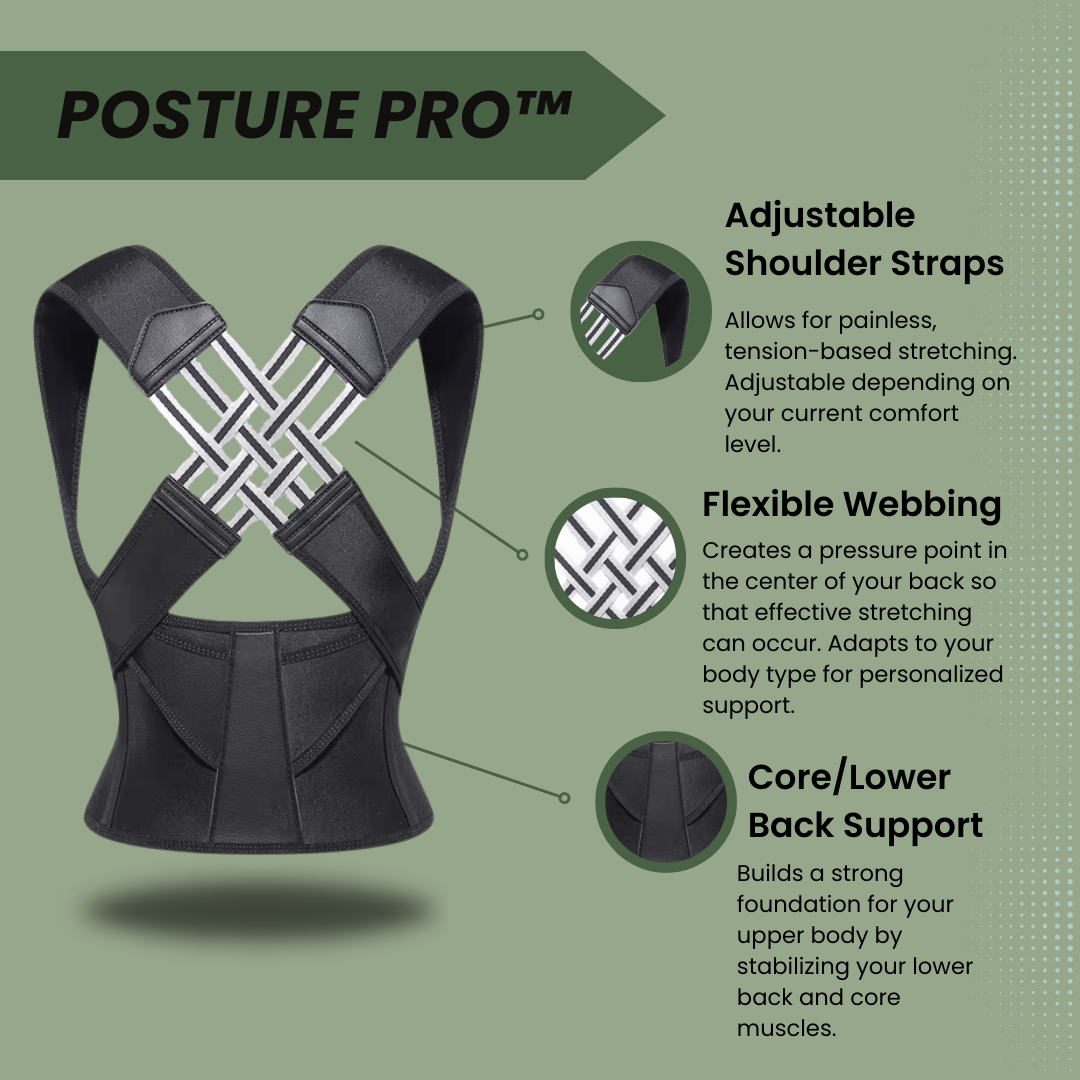Feeling constant back pain can make everyday activities hard. The Long-Term Health Benefits of Alignment for your spine are crucial for relief. This article will guide you through the importance of spinal health and how to achieve it, giving your back the care it deserves. Keep reading to learn more.
Key Takeaways
- Proper spinal alignment is key to reducing pain and preventing long-term health issues. It supports the central nervous system, enhancing communication between the body and brain.
- Daily habits, including maintaining good posture, using ergonomic furniture, and regular exercise, significantly affect spinal health. These practices promote proper spine alignment and prevent discomfort.
- Chiropractic adjustments are crucial for maintaining spinal alignment. They offer relief from migraines, neck-related headaches, and improve overall mobility and nerve function.
- DIY techniques like stretching regularly, strengthening core muscles, practicing good posture, and sleeping on a supportive mattress contribute to lasting spine health.
- Lifestyle changes such as limiting screen time, staying hydrated, avoiding heavy lifting without proper form, and managing stress levels support a healthier spine by minimizing risks of misalignment.
Importance of spinal alignment for overall health
Proper spinal alignment is crucial for the central nervous system to function optimally. This balance supports the communication between the body and brain, ensuring that all systems work together smoothly.
Spinal health also plays a significant role in posture correction, essential for avoiding misalignment issues that can disrupt this critical communication pathway.
Maintaining good posture is not just about looking confident; it's a vital practice for preserving your spine's health.
Chiropractic care provides targeted adjustments that can alleviate migraines and neck-related headaches, demonstrating how closely spinal health is linked to overall well-being. Enhanced nerve function from correct alignment improves pain management, range of motion preservation, and even contributes to better athletic performance and joint health.
These benefits underscore why maintaining proper spinal alignment through professional care or DIY techniques should be a priority for anyone looking to support their long-term health.
Understanding Spinal Alignment
Spinal alignment refers to the correct positioning of the vertebrae in your spine. This positioning plays a significant role in maintaining your overall health and well-being.
Definition and role in health
Spinal alignment refers to the proper positioning of the spine that supports overall health. It keeps your body balanced, allowing for optimal functioning of the central nervous system.
When your spine aligns correctly, it enhances nerve communication throughout your body. This function helps reduce pain and discomfort in areas like the neck and back.
In addition, good spinal alignment improves joint mobility and range of motion in other parts of your body. Poor posture can lead to misalignment, which may cause chronic conditions and long-term pain.
Keeping a healthy posture is crucial for preventing these issues. Proper care through chiropractic adjustments promotes musculoskeletal health and helps relieve problems such as osteoarthritis or muscle fatigue.
The Benefits of Proper Spinal Alignment
Proper spinal alignment greatly reduces pain and discomfort. It enhances nerve flow, promoting better communication within the central nervous system.
Reduced pain and discomfort
Proper spinal alignment significantly reduces pain and discomfort. Misalignment can lead to long-term pain in the back, neck, and joints. Chiropractic care helps realign the spine, improving overall mobility.
Patients often report less strain during daily activities after adjustments.
Effective spinal alignment enhances nervous system function. It supports better communication between the body and brain. This connection leads to less fatigue and a decrease in headaches, including migraines linked to neck issues.
Maintaining good posture is crucial for preventing misalignment and ensuring lasting spine health.
Improved nerve flow
Spinal alignment plays a crucial role in improving nerve flow. Proper alignment allows the central nervous system to function at its best. This leads to better communication between the body and brain.
Misalignment impairs range of motion and can cause long-term pain. Chiropractic adjustments support improved nerve flow, helping to minimize migraines and neck-related headaches. Good posture also prevents misalignment and maintains healthy spine care.
Maintaining proper spinal alignment is essential for overall well-being and athletic performance enhancement.
Prevention of long-term health issues
Proper spinal alignment plays a crucial role in preventing long-term health issues. Misalignment can impair range of motion and lead to ongoing pain. By keeping the spine aligned, individuals enhance nervous system function.
This improved communication within the central nervous system supports overall well-being. Consistent chiropractic adjustments promote better alignment and reduce migraines and neck-related headaches.
Maintaining good posture is vital for avoiding misalignment. Slouching causes stress on the spine, leading to various complications over time. Engaging in regular spine alignment exercises can strengthen back muscles and improve support for proper posture.
Incorporating physical therapy techniques further aids in achieving optimal spinal health while preventing future problems related to osteoarthritis relief and chronic discomfort.
Factors Affecting Spinal Alignment
Daily habits play a significant role in spinal alignment. Poor posture during activities can lead to misalignment and discomfort over time.
Daily habits
Proper daily habits play a crucial role in maintaining spinal health. Good practices can promote optimal alignment and enhance overall well-being.
- Maintain good posture while sitting and standing. Proper spinal alignment helps keep everything in the body working as it should. Slouching and poor posture can lead to misalignment of the spine.
- Take frequent breaks during long periods of sitting. Move around every 30 minutes to avoid stiffness. This practice allows for better blood flow and reduces discomfort.
- Choose ergonomic furniture when working or studying. Ergonomic chairs support the lower back, which promotes proper posture throughout the day. Comfortable desks help maintain correct spinal alignment as well.
- Strengthen core muscles through regular exercise. A strong core supports your spine and improves balance. Enhanced muscular support can help prevent long-term pain from spinal misalignment.
- Stretch regularly to improve flexibility. Flexibility in muscles and joints supports overall range of motion in the spine and other joints. Stretching also helps reduce tension that may affect postural alignment.
- Stay hydrated throughout the day for better joint health. Well-hydrated discs provide cushioning for the spine during movement, reducing wear on vertebrae.
- Avoid heavy lifting without proper form or assistance. Lifting with your legs instead of your back protects your spine from injury or misalignment due to strain.
- Limit screen time on phones, tablets, or computers when possible. Holding devices at eye level helps maintain a neutral neck position, which can prevent neck-related headaches resulting from poor alignment.
- Incorporate relaxation techniques into your routine to manage stress levels effectively. Stress affects muscle tension and can contribute to poor posture, which may interfere with proper spinal alignment.
- Get enough sleep on a supportive mattress that maintains proper spine alignment during rest hours.
Quality sleep prevents stiffness and discomfort by keeping your body balanced overnight.
Trauma and injury
Trauma and injury can significantly impact spinal alignment. A fall, car accident, or sports injury may lead to misalignment in the spine. Misalignment impairs range of motion and can cause long-term pain.
The body struggles to maintain balance without proper alignment. This disruption prevents healthy communication between the central nervous system and the rest of your body.
Poor posture often follows an injury, making matters worse. Slouching after an incident exacerbates spinal issues. Maintaining a good posture is essential for recovery and overall health.
Chiropractic adjustments can help realign the spine after trauma, reducing pain and improving function. With proper care, individuals can restore their spine’s natural alignment over time.
Prevention and maintenance techniques
Proper spinal alignment plays a critical role in health. It ensures the body functions optimally and supports communication across the central nervous system.
- Maintain good posture while sitting, standing, or walking. Proper posture helps prevent slouching, which can lead to misalignment of the spine.
- Engage in regular exercise that strengthens core muscles. A strong core provides support for the spine and improves balance.
- Use ergonomic furniture at work or home. Ergonomic chairs and desks promote better spinal alignment during daily tasks.
- Schedule regular chiropractic adjustments with a professional. These adjustments can help minimize migraines and neck-related headaches while correcting misalignments.
- Stretch frequently throughout the day to increase flexibility. Stretching reduces stiffness and enhances range of motion in the spine and other joints.
- Avoid heavy lifting without proper techniques. Lifting correctly prevents strain on your back, reducing the risk of injury.
- Sleep on a supportive mattress that maintains spinal alignment during rest. This practice allows your spine to recover overnight without unnecessary pressure.
- Keep your weight within a healthy range through balanced nutrition and exercise. Maintaining a healthy weightlessens stress on your spine, promoting overall well-being.
- Perform exercises that focus on mobility and stability for the spine, such as yoga or Pilates. These activities enhance nervous system function and support long-term health benefits.
Implementing these techniques allows you to promote spinal health effectively over time while ensuring proper alignment for greater overall wellness.
Promoting Spinal Health
Maintaining spinal health requires a mix of professional care and daily habits. Regular chiropractic adjustments help keep your spine aligned. You can also practice stretching and strengthening exercises at home.
Good posture plays a crucial role in supporting your spine as well. Small lifestyle changes can make a big difference in how you feel. Explore more tips to enhance your spinal health!
Professional care (chiropractic adjustment)
Chiropractic adjustments play a vital role in maintaining proper spinal alignment. These professional treatments can greatly enhance overall health and well-being.
- Chiropractic care helps restore proper spine alignment. This practice allows for optimal functioning of the central nervous system.
- Adjustments can reduce pain significantly. Many people experience relief from headaches, especially migraines and neck-related issues, after chiropractic treatment.
- Regular sessions improve range of motion in the spine and other joints. Patients often notice increased flexibility and less discomfort during daily activities.
- Enhanced nerve flow occurs with proper spinal alignment. This improvement aids in better communication between the body and brain, supporting overall health.
- Misalignment leads to pain over time. Chiropractic care addresses these issues promptly, preventing long-term complications from developing.
- The spine's balance impacts every part of the body. Proper alignments keep the neck, chest, lower back, and pelvis functioning harmoniously.
- Poor posture contributes to misalignment risks. Chiropractors educate patients on maintaining good posture to minimize potential problems.
- Regular adjustments support long-term health benefits for the spine. Keeping everything aligned promotes continued health throughout life.
- Chiropractic treatment encourages proactive healthcare habits. Patients often adopt lifestyle changes that support spinal health after receiving care.
- Professional care complements self-care techniques effectively. Combining both methods maximizes benefits for lasting spinal wellness.
DIY techniques
Proper spinal alignment is crucial for maintaining overall health. Many do-it-yourself techniques can help promote this alignment effectively.
- Stretch regularly. Stretching aids flexibility and reduces tension in muscles surrounding the spine. Incorporate gentle stretches like cat-cow or child’s pose to support spinal health.
- Strengthen your core. A strong core stabilizes the spine and prevents misalignment. Engage in exercises such as planks or bridges to build strength.
- Practice good posture. Maintain a straight back while sitting, standing, or walking. Good posture ensures that the spine remains aligned and reduces the risk of pain.
- Use ergonomic furniture. Choose chairs and desks that promote proper spine alignment. An ergonomic setup helps maintain a healthy position throughout the day.
- Sleep on a supportive mattress. A quality mattress supports proper spinal alignment during sleep. Ensure it provides enough firmness while remaining comfortable.
- Incorporate balance exercises into your routine. Activities like yoga or tai chi improve coordination and enhance body awareness, promoting better alignment over time.
- Stay active throughout the day. Regular movement mitigates stiffness and promotes healthy communication within the central nervous system.
- Avoid slouching while using devices like smartphones or laptops. Position screens at eye level to prevent poor posture, which leads to misalignment of the spine.
- Take breaks to move around during long periods of sitting or standing still. Frequent movement keeps muscles engaged and encourages proper spinal positioning.
- Focus on your breathing techniques during relaxation exercises or yoga practices to enhance core engagement and support spine alignment effectively.
Tips for maintaining proper alignment
Maintaining proper alignment is essential for a healthy spine. Good posture keeps your body functioning optimally and supports communication within the central nervous system.
- Practice good posture while sitting, standing, and walking. Sit with your back straight and shoulders back to reduce pressure on your spine. Keep your feet flat on the ground or use a footrest.
- Take regular breaks from sitting for long periods. Stand up and stretch every hour to relieve tension in your spine and improve circulation.
- Use ergonomic furniture that promotes proper alignment. Invest in chairs that support the lower back and desks that allow you to keep your computer screen at eye level.
- Strengthen core muscles through exercise. A strong core supports spinal alignment by maintaining balance between the neck, chest, lower back, and pelvis.
- Stay mindful of your body mechanics during daily activities. Bend your knees when lifting heavy objects to protect your spine from undue stress.
- Stretch regularly to maintain flexibility in your spine and joints. Incorporate stretches into your routine to counteract tightness caused by poor posture.
- Seek professional care when necessary; chiropractic adjustments can help maintain spinal alignment effectively, reducing migraines and neck-related headaches.
- Avoid slouching or leaning forward when using digital devices such as smartphones or tablets; this habit leads to misalignment over time.
- Get adequate sleep on a supportive mattress that promotes natural spinal curvature while sleeping on your side or back.
- Be aware of any changes in pain or discomfort levels; these could indicate misalignment issues that require attention for long-term health benefits..
Lifestyle changes for a healthier spine
Spinal health impacts overall well-being. Making lifestyle changes can significantly improve spinal alignment.
- Maintain good posture while sitting and standing. Slouching leads to misalignment, harming the spine and central nervous system communication.
- Incorporate regular exercise into your routine. Activities like walking, swimming, or yoga strengthen muscles and enhance flexibility, which helps maintain proper spinal alignment.
- Invest in ergonomic furniture for workspaces. Proper desk height and supportive chairs reduce strain on the spine during long hours of sitting.
- Stretch daily to improve flexibility in your back and neck. Gentle stretches relieve tension in muscles that support the spine, preventing pain and discomfort.
- Avoid heavy lifting without proper technique. Lifting with your legs instead of your back protects against injury and reduces stress on the spine.
- Stay hydrated to support disc health in your back. Proper hydration maintains cushion between vertebrae, promoting optimal spinal function.
- Schedule regular chiropractic adjustments for optimal spinal alignment. Chiropractic care reduces migraines and improves range of motion by addressing misalignment.
- Limit screen time and take breaks from devices regularly. Prolonged device use often leads to poor posture, which can cause long-term alignment issues in the spine.
- Focus on maintaining a healthy weight through balanced nutrition and exercise routines. Excess weight puts pressure on the spine, contributing to pain and possible misalignment over time.
- Practice mindfulness techniques such as meditation or deep breathing to lower stress levels. Reduced stress can diminish muscle tension around the spine, enhancing overall alignment.
Final word
Posture plays a critical role in spinal alignment. Poor posture, like slouching, can lead to misalignment of the spine. This misalignment impairs range of motion and may cause long-term pain.
Maintaining good posture helps keep the head, trunk, and legs aligned properly. Proper spinal alignment allows for optimal functioning of the central nervous system. It also enhances nerve flow throughout the body.
Good posture supports overall health and well-being. It minimizes discomfort in the neck and back while preventing future health issues. Simple adjustments to daily habits can make a significant difference in how your spine functions over time.
Prioritizing posture is essential for long-term spinal health benefits.



















